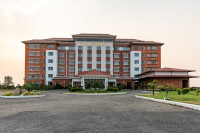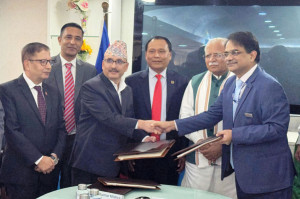Money
Trade deficit soared to Rs1.16t in last fiscal
The country’s trade deficit widened 26.7 percent in fiscal 2017-18 to Rs1,161.63 billion due to slow growth in export earnings and a steep jump in the import bill.
The country’s trade deficit widened 26.7 percent in fiscal 2017-18 to Rs1,161.63 billion due to slow growth in export earnings and a steep jump in the import bill.
As per the macroeconomic report of Nepal Rastra Bank (NRB), merchandised exports in the last fiscal year grew a mere 11.1 percent to Rs81.19 billion while the import bill surged 25.5 percent to Rs1,242.83 billion.
With the slow rise in exports, the ratio of export to the country’s GDP declined to 2.7 percent from 2.8 percent during the review period. The import-to-GDP ratio swelled to 41.3 percent from 37.5 percent.
Likewise, the country’s export-import ratio stood at 1:15.3, meaning Nepal imported Rs15.30 worth of goods for every rupee worth of goods exported. The ratio stood at 1:13.5 in 2016-17.
Imports of petroleum products, vehicles and spare parts, machinery and parts, MS billet and hot-rolled sheet in coil, among others, increased. Petroleum products and vehicles accounted for more than 22 percent of the import bill.
During the period, Nepal’s imports of petroleum products surged 43.1 percent to Rs170.13 billion. Imports of vehicles and spare parts also shot up by 36.1 percent to Rs105.97 billion. Imports of agriculture equipment and parts, sanitary ware, edible oil, small cardamom and zinc ingot, among others, declined.
Meanwhile, exports of cardamom, polyester yarn, sacking, zinc sheet and thread, among others, increased while shipments of GI pipe, twine, juice, woolen carpet and pashmina, among others, decreased. Exports to India increased 12.4 percent to Rs46.6 billion during the review period. Exports to India accounted for 57.4 percent of total exports. Exports to China and other countries increased 43.3 percent and 7.5 percent respectively. Imports from India went up 27.8 percent to Rs809.81 billion, which is 65.15 percent of Nepal’s total imports. Imports from China and other countries increased 25.5 percent and 19.3 percent respectively.
The soaring trade deficit has been attributed to supply constraints and non-tariff barriers. Former commerce secretary Purushottam Ojha said Nepal should address these issues through the Nepal-India Trade Treaty which is proposed to be revised soon.
Consumer inflation eases to 13-year low
KATHMANDU: Nepal’s annual consumer inflation rate eased to a 13-year low at 4.2 percent in the last fiscal year 2017-18.
As per the macroeconomic report of Nepal Rastra Bank, improvement in the supply-chain management and the lower rate of inflation in India contributed to lower level of inflation in Nepal. The report shows that the inflation rate moderated last fiscal year from 4.5 percent in the previous year. A breakdown by geographical region shows that inflation in the mountain region stood at 5.9 percent, followed by hilly region at 4.6 percent and Tarai at 4.4 percent. The consumer inflation rate at the Kathmandu Valley stood at 3.3 percent.
Inflation started moderating in Nepal after India formally adopted flexible inflation targeting in June 2016, making price stability the primary objective of the monetary policy, Nepal’s central bank said. The government has set a target of containing inflation at 7 percent in the current fiscal year.
Remittance income surge 8.6 percent
KATHMANDU: Nepal’s remittance earning increased by 8.6 percent to a record Rs755.06 billion in 2017-18 despite less workers going abroad, according to Nepal Rastra Bank (NRB). The growth rate of remittance in the previous fiscal year was at 4.6 percent.
The report shows that 358,815 individuals were given approval for foreign employment last fiscal year. Malaysia was the first choice for outbound workers. The number of workers going to the country stood at 104,207, a rise by 5.86 percent. Similarly, 103,174 individuals received approval to work in Qatar, the second most popular destination in the list. It was followed by UAE, Saudi Arabia and Kuwait, among others.
During the review period, the number of migrant workers to Malaysia, UAE, Kuwait and Bahrain increased while those to Qatar, Saudi Arabia, South Korea and Oman declined. Remittance inflow slowed from mid-November which lasted till mid-January of the last fiscal year. (PR)




 23.12°C Kathmandu
23.12°C Kathmandu














